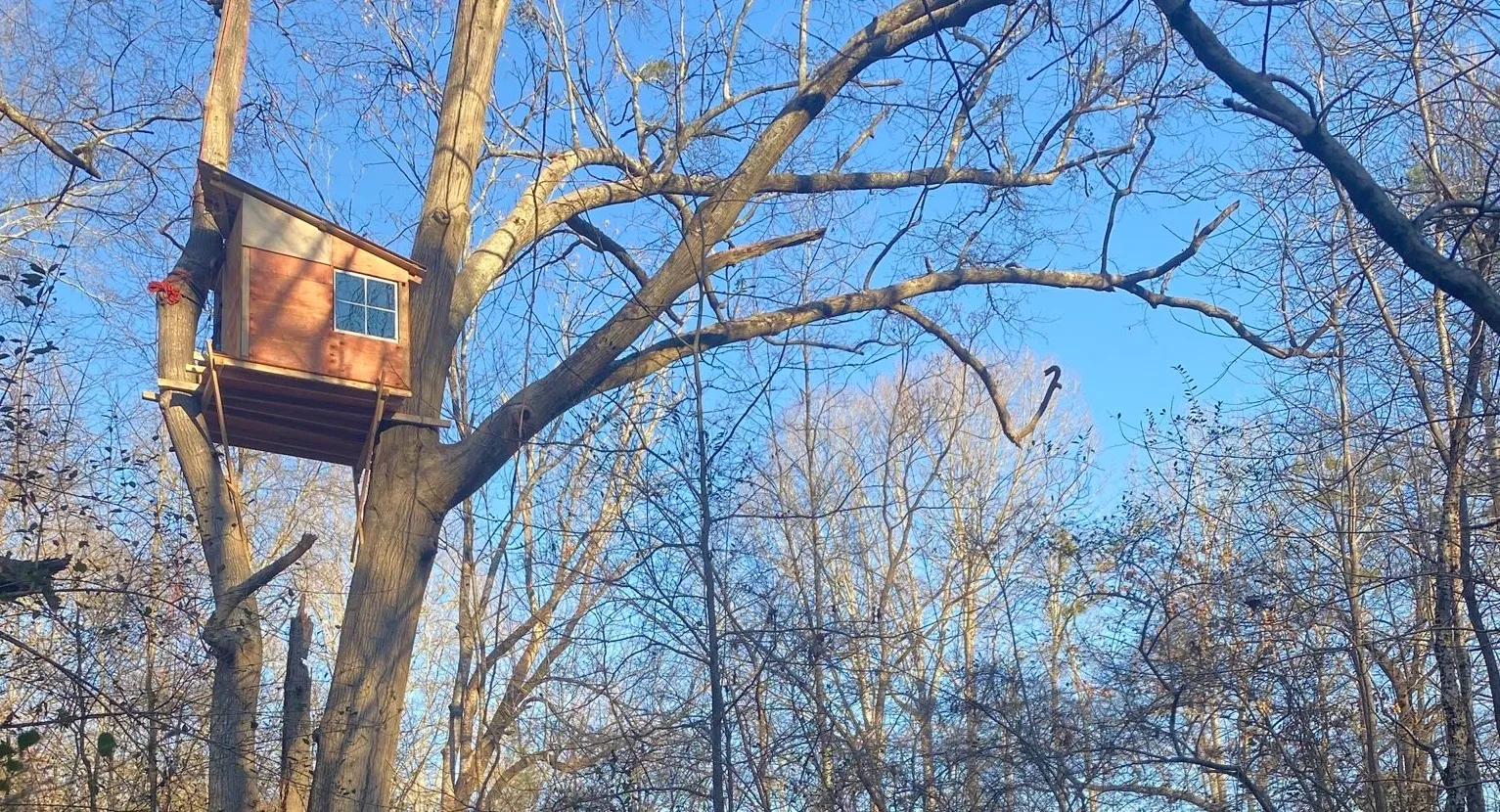Tyler Estep, “DeKalb judge allows lawsuit over film studio land swap to proceed,” The Atlanta Journal-Constitution, March 21, 2022, ➝.
Mark Auslander, “Songs of the Forest: A ‘Re-matriation’ Gathering in Weelaunee (South River) Forest,” April 26, 2022, ➝.
The Raury Thing (LIVE @ The Woods), July 23, 2022, ➝.
Ryan Fatica, “Atlanta Fights to Save its Forest,” Unicorn Riot, May 14, 2022, ➝; Charles Bethea, “The New Fight Over an Old Forest in Atlanta,” The New Yorker, August 3, 2022, ➝; Ella Fassler, “Activists Are Occupying the Woods of Atlanta to Block a New Police Facility,” Vice Motherboard, February 17, 2022, ➝.
Eric Kuehler, “Putting Numbers to Stormwater and Other Benefits of Atlanta's Urban Forest,” US Forest Service, Urban Forestry South, February 4, 2020, ➝
USGCRP, “Fourth National Climate Assessment: Chapter 19: Southeast,” NCA4, ➝.
Emily Jones and Molly Samuel, “The Heat Effect: How the Climate is Changing Georgia,” WABE, June 22, 2022, ➝.
Jeremy Fuster, “Atlanta Studio Sparks Protests for Plan to Clearcut 200-Acre Forest for More Soundstages,” Wrap Pro, July 7, 2021, ➝.
David J. Nowak and Daniel E. Crane, “Carbon storage and sequestration by urban trees in the USA,” Environmental Pollution 116, no. 3 (2002): 381–389; Ian D. Yesilonis and Richard V. Pouyat, “Carbon stocks in urban forest remnants: Atlanta and Baltimore as case studies.” In: R. Lal and B. Augustin., eds. Carbon sequestration in urban ecosystems (Dordrecht: Springer, 2012): 103–120.
City of Atlanta Department of City Planning (2017) The Atlanta City Design: Aspiring to the Beloved Community, 330-337, ➝.
Mathew E. Hauer, “Migration induced by sea-level rise could reshape the US population landscape,” Nature Climate Change 7 (2017): 321–325.
Robinson Meyer, “We’re Hitting the Limits of Hurricane Preparedness,” The Atlantic, August 29, 2021, ➝.
Parag Khanna has been named as one of Esquire’s “75 Most Influential People of the 21st Century,” and has worked for the World Economic Forum, the Brookings Institution, and the US Special Operations Forces in Iraq and Afghanistan. Parag Khanna, “Climate migration is here. The U.S. must invest accordingly,” Washington Post, November 17, 2021, ➝.
See, e.g., Jeff D. Opdyke, “Global Warming: These Northern Cities Offer Attractive Refuge,” Guaranteed Rate, ➝.
“Buffalo Mayor Byron Brown delivers 2019 State of the City Address,” News 4 WIVB Buffalo, February 15, 2019, ➝.
Kendra Pierre-Louis, “Want to Escape Global Warming? These Cities Promise Cool Relief,” New York Times, April 15, 2019, ➝.
Craig Schneider and Mark Davis, “Katrina Evacuees Rebuild, Remember,” The Atlanta Journal-Constitution, August 30, 2015, ➝.
DJ Nowak and E. Greenfield, “Declining urban and community tree cover in the United States,” Urban Forestry & Urban Greening 32 (2018): 32–55.
On the Atlanta Way and the George Floyd Uprising in Atlanta, see “The City in the Forest: Reinventing Resistance for an Age of Climate Crisis and Police Militarization,” Crimethinc, April 4, 2022, ➝; see also Ernie Suggs and Rosalind Bentley, “‘Atlanta Way’ challenged after violent night of protests,” The Atlanta Journal-Constitution, May 30, 2020, ➝.
Shemon Salam and Arturo Castillon, The Revolutionary Meaning of the George Floyd Uprising (Québec: Daraja Press, 2021); Raisa Habersham, “Atlanta mayor urges violent protesters: ‘Go home’,” The Atlanta Journal-Constitution, May 29, 2020, ➝.
US Army, “Megacities: Urban Future, the Emerging Complexity,” The Intercept, October 13, 2016, ➝.
Andrew Boryga, “Atlanta’s ‘Cop City’ Will Become a Reality, Despite Pushback,” The Daily Beast, September 9, 2021, ➝.
Stephanie Wakefield, Sarah Molinari, and Kevin Grove, “Crypto-Urban Statecraft: Post-Pandemic Urban Governance Experiments in Miami,” Urban Geography (2022).
David Madden, “The Urban Process Under Covid Capitalism,” City 24, no. 5–6 (2020): 677.
Ibid., 678.
Ayona Datta, “Self(Ie)-Governance: Technologies of Intimate Surveillance in India under COVID-19,” Dialogues in Human Geography 10, no. 2 (2020): 234–237; Bei Chen, Simon Marvin, and Aidan While, “Containing COVID-19 in China: AI and the Robotic Restructuring of Future Cities,” Dialogues in Human Geography 10, no. 2 (2020): 238–421; Ola Söderström, “The Three Modes of Existence of the Pandemic Smart City,” Urban Geography 42, no. 3 (2021): 399-407.
“Ryan Millsap sells Blackhall Studios, plans new ventures,” Saporta Report, April 28, 2021, ➝.
Gene Maddaus, “Blackhall Studios Announces New Name and New $500 million Investor,” Variety, June 14, 2022, ➝.
➝.
➝.
Ida Auken’s essay has since been removed from the WEF’s site, but it was also published here: ➝.
Desiree Fields, “Corporate Landlords and Market Power: What Does the Single-family Rental Boom Mean for our Housing Future,” Presentation, Atlanta Regional Housing Forum, June 1, 2022, ➝.
Maureen Farrell, “Blackstone expands further into rental housing in the United States,” New York Times, February 16, 2022, ➝.
Alan Judd and Willoughby Mariano, “At violent apartment complexes, business model thrives on housing shortage, government inaction,” The Atlanta Journal-Constitution, June 9, 2022, ➝.
Atlanta Community Press Collective (@atlanta_press), “The rally to #StopCopCity today was a glowing success. Nearly 50 people gathered with signs and formed an impromptu car caravan to deliver flowers and signs of support to tree sitters.” Twitter post, June 7, 2022, ➝; La'Tasha Givens, “'It’s not for our community,’” 11 Alive News, June 7, 2022, ➝.
